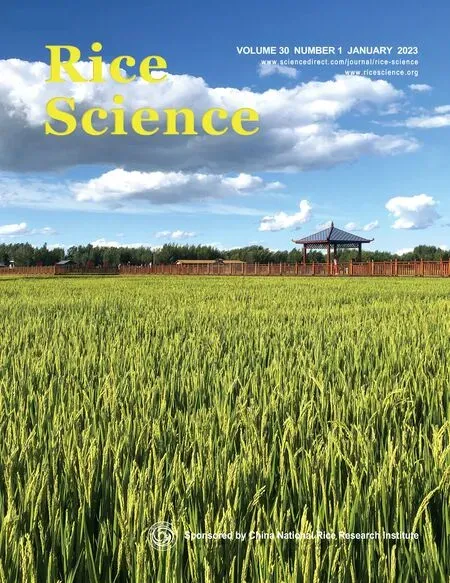Rational Design of Grain Size to Improve Rice Yield and Quality
Rational Design of Grain Size to Improve Rice Yield and Quality
SUPPLEMENTAL DATA
File S1. Methods
Rice materials and growth conditions
JXY1 and NJ0378 () cultivars were used for-mediated co-cultivation transformation experiments. Plants were grown in Nanjing, Jiangsu Province, China with natural long day conditions in a paddy field.
Plasmid construction
Under the guidance of CRISPR Primer Designer (http://www.plantsignal.cn), the target sequences of gene editing were selected and the target sequence-containing chimeric primers were designed (Yan et al, 2015). The CRISPR/Cas9 expression vector was constructed according to the protocol previously described (Ma et al, 2015). The vector was transformed into E.strain DH5and confirmed by sequencing.
Rice transformation and mutation detection
The CRISPR/Cas9 constructs were introduced intostrain EHA105 by heat-shock. Rice transformation was performed as described previously (Tian et al, 2015)At T0generation, genomic DNA was extracted from leaves of transgenic rice plants. The target sequences of,andwere amplified and then sequenced in Tsingke Company, Beijing, China. The transgenic lines with mutations were chosen and used for further analysis. All primers used in this study are listed in Table S6.
Evaluation of agronomic traits
Before harvest, several yield-related agronomic traits were measured, including plant height and panicle number. Grain-related traits, including grain length, grain width and 1000-grain weight, were measured after harvesting and stored at 37 oC for one week. The full-filled grains per plant were weighed to determine the grain yield per plant. Data statistics and sample-tests were analyzed using the Excel (2016) software.

Fig. S1. Vector construction and genotype of each line.
Red arrows are the target sites. Red nucleotides indicate the inserted bases and the red strickout lines (?) indicate the deleted nucleotides.

Table S1. Comparisons of yield traits in JXY1 and mutants.
Data are Mean ± SD (= 7). *< 0.05 and **< 0.01.

Table S2. Rapid Visco Analyzer profile characteristics of JXY1 and mutants.
Data are Mean ± SD (= 3). *< 0.05 and **< 0.01.

Table S3. Comparisons of yield traits in NJ0378 and mutants.
Data are Mean ± SD (= 7). *< 0.05 and **< 0.01.

Table S4. Rapid Visco Analyzer profile characteristics in NJ0378 and mutants.
Data are Mean ± SD (= 3). *< 0.05 and **< 0.01.
Table S5. Analysis of potential off-target sites.

IDTarget and off-target sequenceNo. of mismatchesMutation detected GS9 site GTCCTGGCCTTTCCACGCGA On target+ GS9-off-target1 GTCCTGTCCTTTCCACTAGA 3? GS9-off-target2 GTCGTGGCCGATCACCGCGA 5? GS9-off-target3 CTCCTCGCCTTTGCACGCCC 5? GS9-off-target4 GTCCTTGCCTTTCCTCGCCA 3? GS9-off-target5 GTCCGGGCCGCTCCACGCGA 3 ? - GS9-off-target6 GTCCTGGCCTTGACACGCGC 3? GS9-off-target7 GTCCTCGCCTTTCGACGCGG 3? GS9-off-target8 GTCCAGGCACTGCGACGCGA 5? TGW6 site GAGAAGCACGGCGAGGCAAG On target+ TGW6-off-target1 GGAGAGCACGGCGAGGCAAG 3? TGW6-off-target2 GCGAAGCACGGCGAAGCTAC 5? TGW6-off-target3 AAGCAGCACGGCGAGGCCAG 2? TGW6-off-target4 GAGAAGGATGGCGATGCAAG 9? TGW6-off-target5 GGCAAGCCCCGCGAGGCAAG 5? TGW6-off-target6 GAGGAGGACGGCGAGGAAGG 4 ? - TGW6-off-target7 GAGGAGCGCGGCGAGGCAGG 3? TGW6-off-target8 GAGCAGCACGGCGAGGGCAG 3? qGL3 site AATGCACGTCTCCATGTATC On target+ qGL3-off-target1 AATGCACGACTTCATGTCTC 3? qGL3-off-target2 AATGCAAGTGAACTTGTATC 5? qGL3-off-target3 CAATCCCGTCTCCATGCATC 5? qGL3-off-target4 AGTGCAGGTTTCCATGAAAC 5? qGL3-off-target5 AATCGAAGTCGCCATGTATC 4? qGL3-off-target6 GATGCACGTCTCCAAGTCTG 4?
Red bases are mismatches; ‘+’, Mutation detected; ‘?’, Mutation not detected.

Table S6. Primers used in this study.
Yan M, Zhou S R, Xue H W. 2015. CRISPR Primer Designer: Design primers for knockout and chromosome imaging CRISPR-Cas system., 57(7): 613–617.
Ma X L, Zhang Q Y, Zhu Q L, Liu W, Chen Y, Qiu R, Wang B, Yang Z F, Li H Y, Lin Y R, Xie Y Y, Shen R X, Chen S F, Wang Z, Chen Y L, Guo J X, Chen L T, Zhao X C, Dong Z C, Liu Y G. 2015. A robust CRISPR/Cas9 system for convenient, high-efficiency multiplex genome editing in monocot and dicot plants., 8(8): 1274–1284.
Tian X J, Wang Z Y, Li X F, Lv T X, Liu H Z, Wang L Z, Niu H B, Bu Q Y. 2015. Characterization and functional analysis of pyrabactin resistance-like abscisic acid receptor family in rice., 8(1): 28.
- Rice Science的其它文章
- Stay-Green Panicle Branches Improve Processing Quality of Elite Rice Cultivars
- Defensive Role of Plant Hormones in Advancing Abiotic Stress-Resistant Rice Plants
- Stay-Green Panicle Branches Improve Processing Quality of Elite Rice Cultivars
- Brassinosteroids Mediate Endogenous Phytohormone Metabolism to Alleviate High Temperature Injury at Panicle Initiation Stage in Rice
- Knocking-Out OsPDR7 Triggers Up-Regulation of OsZIP9 Expression and Enhances Zinc Accumulation in Rice
- Differential Expression of Iron Deficiency Responsive Rice Genes in Low Phosphorus and Iron Toxicity Conditions and Association of OsIRO3 with Yield under Acidic Soils

